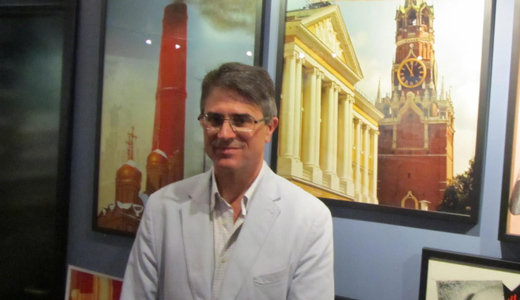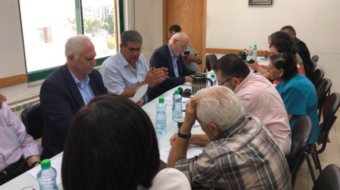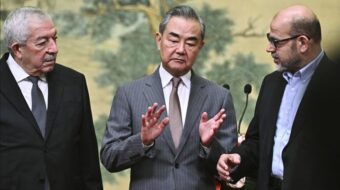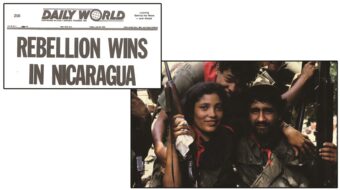
CULVER CITY, Calif. – American-born Justin Lifflander, graduate of Cornell University, arrived in Russia (then the USSR) in 1987 as a driver-mechanic for the U.S. embassy in Moscow. Within the year he found himself serving as a missile inspector at a Soviet production plant, as authorized by the Intermediate Nuclear Forces Treaty (INF) signed by Ronald Reagan and Mikhail Gorbachev. (Remember Reagan’s slogan “Trust but verify?” – this was the verify part.)
Lifflander was stationed in the small town of Votkinsk, undistinguished in any way except that it happens to be the birthplace of composer Peter Ilyich Tchaikovsky. Votkinsk, in the Udmurt Republic, is located in a restricted area (because of its military manufacturing) 631 miles as the crow flies and one time zone due east of Moscow, in the foothills of the Ural Mountains, where foreigners from any other country are rarely seen.
There he met a young woman who had been assigned by the KGB to be his “escort” (“minder” might be the more familiar word). Short story: They fell in love, the Soviet Union imploded, they married, he became a dual American-Russian citizen, and he has lived and worked in Russia for nearly thirty years now.
On April 27, Lifflander came to the Wende Museum, a unique institution dedicated to the history of the Cold War, located in this city nestled into the L.A. urban sprawl, to give a power point lecture, “What’s Old is New: A Personal Perspective on Disarmament, the End of the Last Cold War and the Start of a New One.”
“Something like a new Cold War” has been emerging since about the year 2000, Lifflander says. The era we live in contrasts sharply with the Reagan-Gorbachev moment, a short historical interlude that understandably looms large in Lifflander’s personal history.
The two world leaders met in person five times. Despite their positions as heads of the lead nations in the two major opposing political and economic blocs in the world, they developed a mutual admiration and even friendship. Reagan began, of course, with great bluster about the Strategic Defense Initiative and talk of the USSR as the “evil empire.” But over time, Reagan and his advisors, including his longtime Secretary of State George Shultz (1982-89), came to see the folly of mutually assured destruction (M.A.D.), and started seeking ways to curtail the nuclear threat. One could argue that the Soviets had been pursuing the path of peaceful coexistence for many years already.
The character of Reagan’s new approach included a commitment to consistency, open-mindedness, de-linkage (not thwarting progress in this area because of disagreements in that area), compromise, on-site inspection, and an articulated vision of a better, safer world. According to Shultz, meeting your counterpart is not evidence of weakness.
Alongside this fresh attitude of political openness would surely come economic development, from the diminution of the nuclear and military budget for one thing. Perhaps even then the “Tear down this wall” president was already anticipating the collapse of the socialist model and the availability of new entrepreneurial opportunities.
In any case, the INF treaty did indeed eliminate a whole class of nuclear weapons on both sides. Interestingly, in an official map of Soviet INF launch sites that Lifflander projected, most of them were strung out for thousands of miles adjacent to the Chinese border. The Soviets were obviously far more fearful of the Chinese than of the Europeans or Americans. The speaker wryly commented that, to date, China has never thanked the U.S. for helping to remove that particular nuclear threat along its border with Russia.
What happened?
In 1988, Reagan’s last year in office, the United States and the USSR had some 86 ongoing intergovernmental negotiations proceeding on a wide variety of subjects. At the end of the year 2014, there were none between the U.S. and Russia. Zero. A virtually complete lack of communication had frozen into place.
In 1991, approval of the U.S. in Russia peaked at 80 percent. In 2015, 59 percent of respondents in Russia saw the U.S. as a threat.
The 1990 reunification of Germany – which for historic reasons the USSR considered a most dangerous prospect – came about because of a promise the U.S. made not to expand NATO in the newly capitalist countries of Eastern Europe that had been part of the socialist Warsaw Pact. But with the collapse of that bloc, U.S. arrogance soared. America was now the “unipower” in a formerly bipolarized world. “Who cares what Russia thinks?” became the tacit, if unstated U.S. policy.
The new outlook became visible in many ways. First and foremost, the invitation to Eastern European states to join NATO, thus installing U.S. military bases, troops and missiles practically at Russia’s borders. Gone now was that precious buffer zone that protected this great but vulnerable power which, after all, had its national historical pride and a certain zone of influence to which it had long felt entitled, dating from long before the Soviets. This stage took place largely under the aegis of President Bill Clinton, but it is evidenced still, for example in blatant U.S. interference in Ukrainian politics.
In other smaller but meaningful ways the new attitude manifested itself. Diplomats assigned to embassy and consular posts in Russia did know Russian, much less the country’s sensitivity to territorial insecurity. The embassies replaced local employees with contracted workers from the States. Dinner parties were reduced from seven-course, evening-long affairs to three-course working sessions where both sides could informally “roll up their sleeves” and talk, forgetting that diplomatic niceties over vintage wines can strongly convey an honorable sense of respect and appreciation.
In a mild but pointed critique of President Obama, Lifflander observes that in his cool reserve he is not known for the warmth of his relations with world counterparts. There seems to be a mutuality of understanding with Germany’s long-serving Chancellor Angela Merkel, but one would be hard pressed to name another close partnership.
“We don’t seem to be working toward cooperation with Russia,” Lifflander says. “Maybe we could become a little more humble.”
Where to begin? We could start, Lifflander proposes, by working together to resolve the tragedy of Syria, and then advance to solutions in the Middle East as a whole. Global warming calls for mutual agreements, and (this seemed less urgent and more symbolic to my ears) a joint manned mission to Mars.
Justin Lifflander was an executive with Hewlett-Packard Russia for two decades, after which he became business editor of the Moscow Times daily newspaper. He calls himself a Democrat and says he voted twice for Obama. Cuba, he says, is his “third favorite country in the world,” and he has visited it many times. To this listener he sounded rational and hopeful, even if against formidable odds.
Justin Lifflander’s whole biography is wrapped up in American-Russian history and owes its shape to the Reagan-Gorbachev relationship, over which hover a plethora of controversies, of course. Lifflander’s is certainly not the final word. Yet during that time, there was cooperation on the highest level, there were critical agreements, there were demonstrable milestones of demilitarization. His memoir, overflowing with comic incident, How Not to Become a Spy: A Memoir of Love at the End of the Cold War, was published in English in 2014 and in Russian at the end of last year.
The book includes a sad kind of epitaph: There’s a photo of the monument to the INF treaty near the U.S. inspectors’ housing, and the plaque reads:
“In accordance with the treaty between Russia and the USA on the liquidation of their intermediate range missiles (INF), for the first time in history during the period from 1 July 1988 to 31 May 2001, a treaty to destroy strategic nuclear weapons was implemented. Here, next to the Votkinsk Machine Building Factory, a residential complex was constructed for thirty American inspectors who continuously verified the fulfillment by Russia of its commitment to no longer manufacture missiles covered by the INF Treaty. (The same work was carried out by Russian inspectors in the state of Utah in the USA.)”
For more information see: The Wende Museum and Justin Lifflander.
Photo: Justin Lifflander with works in the Wende Museum’s exhibition “Artistic Interpretations of the Cold War.” / Eric A. Gordon PW












Comments